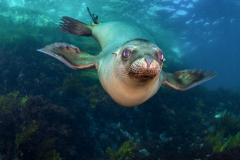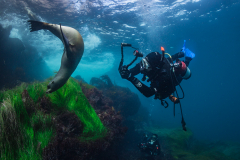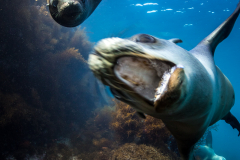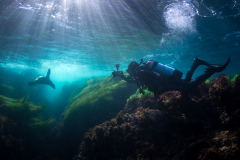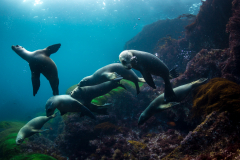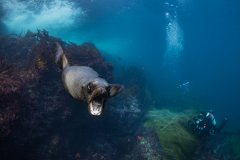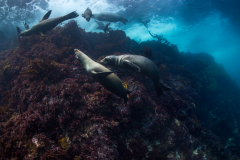Although they’re only 8 miles off the Baja Peninsula and approximately 15 miles from San Diego, the Coronado Islands remain largely unheard of outside of San Diego and Arizona diving circles. The Coronado Islands fall within the jurisdiction of the Mexican state of Northern Baja California, and other than a small military detachment, they are an uninhabited wildlife refuge. Getting to the Coronado Islands is easy — and worth it for some of the best visibility and large-animal encounters in the area. Photographers do not want to miss this hidden gem.
What will you see?
Many creatures one might encounter on a San Diego shore dive live throughout the Coronado Islands as well, with one key difference: good visibility. On a good day, divers can expect anywhere from 30 to 70-foot (9 to 21 m) visibility, with the average around 50 feet (15m). Water temperatures range from 60 to 70 F (15 to 21 C) on the surface, although occasionally thermoclines drop down to the low 50s (10s C) at depth. A 7 mm wetsuit and hood are recommended, and you can always ditch the hood if the water is warm.
The main attraction here is the sea-lion interaction. Begin with the Lobster Shack dive site, a small sea lion colony of about 40 to 60 animals located at North Coronado Island. They are able to thrive here because of the abundance of food and lack of human development. Depths at this site range from 10 to 70 feet. (3 to 21 m), although divers looking for the action tend to go no further than 15 feet (4.5 m), as the sea lion pups will compete for your attention immediately upon entering the water. These curious, friendly pups will blow bubbles in your face while mom cautiously watches from nearby. Occasionally an adult will pass by the group, checking on the little ones and to make sure divers know parents are present and watching.
Getting to Coronado requires a 90-minute boat ride, departing from San Diego, and your passport since you’re crossing international borders. You also need a Mexican tourist visa, which runs around $35 USD. Book with a professional dive charter, as they will take care of all the paperwork, visa included, leaving you more time to enjoy what you came for –– splashing into the water with sea lion pups while they buzz about.
Remember to bring your seasickness meds, hat, and a warm change of clothes for the ride back.
Photography tips for diving the Coronado Islands
- Bring a flash or two to freeze the action of agile pups mid-swoop.
- If you find the sea lion activity, try to set up wide-angle framing, including some green seagrass and red sargassum. Find your spot and wait patiently for the curious pups to come to you. This will lead to beautiful megafauna wide-angle images.
- Be aware of bulls — large male sea lions in the area — especially during June and July, which is breeding season. During this time the bulls become more territorial and protective of the young pups, so station yourself further away from the rocks where the colony lives. These big guys can weight over 750 pounds (340 kg).
- Try not to surface close to the colony. Sea lions do not feel threatened by humans underwater because they’re agile in the water, but on the surface, they are not quite as quick. Therefore, you can easily spook them you surface close to shore.
- Good buoyancy control is a must because of shallow dive-site depths accompanied by surge and current.
Interested in diving the Coronado Islands?
Whether you’re a San Diego native or looking for an easy day-trip getaway, these islands are worth experiencing for some fantastic sea lion encounters. Dive charters to the Coronado Islands run weekly, departing from San Diego, with the best season running October through November.
Frankie Grant is an internationally published marine photojournalist and PADI IDC Staff instructor, who enjoys nothing more that sharing his passion for the ocean with his students and peers. Throughout the year, Frankie conducts dive expeditions and imaging workshops both locally and abroad. You can see more of his work on his website or on Instagram.


